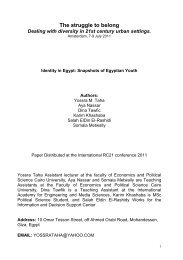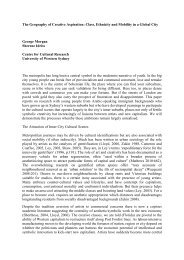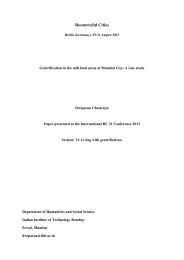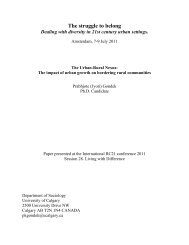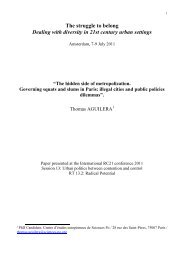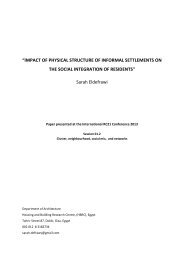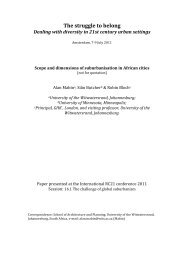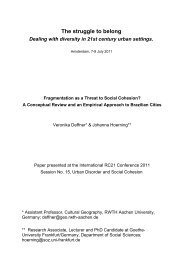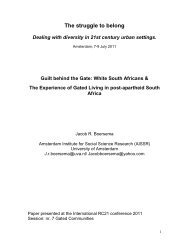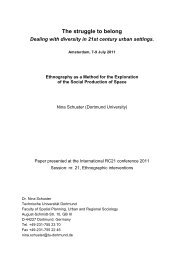Gentrification as a broad process of reurbanization - RC21 ORG ...
Gentrification as a broad process of reurbanization - RC21 ORG ...
Gentrification as a broad process of reurbanization - RC21 ORG ...
Create successful ePaper yourself
Turn your PDF publications into a flip-book with our unique Google optimized e-Paper software.
Judit Veres CEU Budapest<br />
smaller towns, <strong>of</strong> the districts <strong>of</strong> the capital to the municipality, and reshuffling the<br />
counties and regions. There is a plethora <strong>of</strong> initiatives, policy recommendations,<br />
regulations and laws all advanced by the governing party, which at this stage all point<br />
towards a consolidation <strong>of</strong> this governing elite‘s grip on power.<br />
One <strong>as</strong>pect <strong>of</strong> this frenzy <strong>of</strong> consolidating one‘s grip one power is the obvious<br />
preoccupation with symbolic and affective practices <strong>of</strong> place making, <strong>of</strong> control <strong>of</strong><br />
visual images, most immediately noticeable in the renaming <strong>of</strong> streets and public<br />
squares; Roosevelt square becoming Széchenyi square and Moszkva square renamed<br />
Széll Kálmán square, in changing or disciplining the directors <strong>of</strong> the most prestigious<br />
cultural institutions etc. This happens against a larger context <strong>of</strong> economic and<br />
cultural globalization when the promoting <strong>of</strong> culture to cities in its various guises,<br />
such <strong>as</strong> a Guggenheim museum, or a Tate Modern, or <strong>as</strong> the preservation <strong>of</strong><br />
architectural landmarks or various forms <strong>of</strong> cultural heritage, <strong>as</strong> a cultural strategy <strong>of</strong><br />
economic development points towards an entrepreneurialism <strong>as</strong> a speculative<br />
construction <strong>of</strong> place in the sense that all these strategies are meant to attract and<br />
promote flows <strong>of</strong> mobile international capital and tourism through branding and<br />
selling an attractive city to investors and visitors.<br />
“The turn <strong>of</strong> the century are the years <strong>of</strong> development, <strong>of</strong> industrialization, Budapest is born at this<br />
time, and immediately becomes a really big city, a bit bigger than itself― (Péter Esterházy, p. 195, my<br />
translation).<br />
―Everybody w<strong>as</strong> born at that time; Joyce, Musil, Broch, Rilke, Thom<strong>as</strong> Mann, Kafka, Einstein, Pic<strong>as</strong>so,<br />
Wittgenstein, everybody who mattered w<strong>as</strong> there at their cradle, “tout Paris“ . The so-called<br />
Hungarian cl<strong>as</strong>sics come from that time, too; Ady Endre, Babits Mihály, Móricz Zsigmond, Juhász<br />
Gyula, K<strong>as</strong>sák Lajos, Bartók, Kodály. At the rurn <strong>of</strong> the century everything worked out beautifully.<br />
Before the world collapsed, everything just worked out beautifully.― (ibid)<br />
In March 2011 a roundtable discussion took place about the necessity to rethink the<br />
mid- and long-term urban development strategies <strong>of</strong> Budapest, gathering planners,<br />
architects, mayors, journalists etc. with the aim to define the future vision, the brand<br />
that can sell Budapest well to tourists and investors.<br />
One <strong>of</strong> the participants‘ remark somehow resonates with the Esterhazy quote above,<br />
when remarking the fact that Budapest, although <strong>of</strong>ten compared to either Vienna,<br />
7




